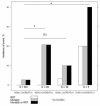Additive value of blood neutrophil gelatinase-associated lipocalin to clinical judgement in acute kidney injury diagnosis and mortality prediction in patients hospitalized from the emergency department
- PMID: 23402494
- PMCID: PMC4056001
- DOI: 10.1186/cc12510
Additive value of blood neutrophil gelatinase-associated lipocalin to clinical judgement in acute kidney injury diagnosis and mortality prediction in patients hospitalized from the emergency department
Abstract
Introduction: Acute kidney injury (AKI) is a common complication among hospitalized patients. The aim of this study was to evaluate the utility of blood neutrophil gelatinase-associated lipocalin (NGAL) assessment as an aid in the early risk evaluation for AKI development in admitted patients.
Methods: This is a multicenter Italian prospective emergency department (ED) cohort study in which we enrolled 665 patients admitted to hospital from the ED.
Results: Blood NGAL and serum creatinine (sCr) were determined at ED presentation (T0), and at: 6 (T6), 12 (T12), 24 (T24) and 72 (T72) hours after hospitalization. A preliminary assessment of AKI by the treating ED physician occurred in 218 out of 665 patients (33%), while RIFLE AKI by expert nephrologists was confirmed in 49 out of 665 patients (7%). The ED physician's initial judgement lacked sensitivity and specificity, overpredicting the diagnosis of AKI in 27% of the cohort, while missing 20% of those with AKI as a final diagnosis.
Conclusions: Our study demonstrated that assessment of a patient's initial blood NGAL when admitted to hospital from the ED improved the initial clinical diagnosis of AKI and predicted in-hospital mortality. Blood NGAL assessment coupled with the ED physician's clinical judgment may prove useful in deciding the appropriate strategies for patients at risk for the development of AKI.See related commentary by Legrand et al., http://ccforum.com/content/17/2/132.
Figures






Comment in
-
The elusive task of biomarkers of renal injury.Crit Care. 2013 Apr 17;17(2):132. doi: 10.1186/cc12578. Crit Care. 2013. PMID: 23595019 Free PMC article.
Similar articles
-
Plasma NGAL for the diagnosis of AKI in patients admitted from the emergency department setting.Clin J Am Soc Nephrol. 2013 Dec;8(12):2053-63. doi: 10.2215/CJN.12181212. Epub 2013 Sep 5. Clin J Am Soc Nephrol. 2013. PMID: 24009223 Free PMC article.
-
Diagnostic and short-term prognostic utility of plasma pro-enkephalin (pro-ENK) for acute kidney injury in patients admitted with sepsis in the emergency department.J Nephrol. 2015 Dec;28(6):717-24. doi: 10.1007/s40620-014-0163-z. Epub 2014 Dec 9. J Nephrol. 2015. PMID: 25486879
-
Plasma neutrophil gelatinase-associated lipocalin as a predictive biomarker for the detection of acute kidney injury in adult poisoning.Clin Toxicol (Phila). 2016;54(2):127-33. doi: 10.3109/15563650.2015.1118487. Epub 2015 Dec 18. Clin Toxicol (Phila). 2016. PMID: 26683351
-
Diagnostic value of neutrophil gelatinase-associated lipocalin for early diagnosis of cardiac surgery-associated acute kidney injury: a meta-analysis.Eur J Cardiothorac Surg. 2016 Mar;49(3):746-55. doi: 10.1093/ejcts/ezv199. Epub 2015 Jun 20. Eur J Cardiothorac Surg. 2016. PMID: 26094017 Review.
-
[Performance neutrophil gelatinase-associated lipocalin in clinical settings].Przegl Lek. 2013;70(6):400-3. Przegl Lek. 2013. PMID: 24052978 Review. Polish.
Cited by
-
The Risk and Clinical Implications of Antibiotic-Associated Acute Kidney Injury: A Review of the Clinical Data for Agents with Signals from the Food and Drug Administration's Adverse Event Reporting System (FAERS) Database.Antibiotics (Basel). 2022 Oct 6;11(10):1367. doi: 10.3390/antibiotics11101367. Antibiotics (Basel). 2022. PMID: 36290024 Free PMC article. Review.
-
Soluble Programmed Cell Death Protein 1 and Its Ligand: Potential Biomarkers to Predict Acute Kidney Injury After Surgery in Critically Ill Patients.J Inflamm Res. 2022 Mar 24;15:1995-2008. doi: 10.2147/JIR.S356475. eCollection 2022. J Inflamm Res. 2022. PMID: 35356070 Free PMC article.
-
Year in review 2013: Critical Care - nephrology.Crit Care. 2014 Oct 21;18(5):574. doi: 10.1186/s13054-014-0574-1. Crit Care. 2014. PMID: 25426759 Free PMC article. Review.
-
Utility of suPAR and NGAL for AKI Risk Stratification and Early Optimization of Renal Risk Medications among Older Patients in the Emergency Department.Pharmaceuticals (Basel). 2021 Aug 25;14(9):843. doi: 10.3390/ph14090843. Pharmaceuticals (Basel). 2021. PMID: 34577543 Free PMC article.
-
Urinary neutrophil gelatinase-associated lipocalin-guided risk assessment for major adverse kidney events after open-heart surgery.Biomark Med. 2018 Sep;12(9):975-985. doi: 10.2217/bmm-2018-0071. Epub 2018 Aug 8. Biomark Med. 2018. PMID: 30088425 Free PMC article. Clinical Trial.
References
-
- Nickolas TL, Schmidt-Ott KM, Canetta P, Forster C, Singer E, Sise M, Elger A, Maarouf O, Sola-Del Valle DA, O'Rourke M, Sherman E, Lee P, Geara A, Imus P, Guddati A, Polland A, Rahman W, Elitok S, Malik N, Giglio J, El-Sayegh S, Devarajan P, Hebbar S, Saggi SJ, Hahn B, Kettritz R, Luft FC, Barasch J. Diagnostic and prognostic stratification in the emergency department using urinary biomarkers of nephron damage a multicenter prospective cohort study. J Am Coll Cardiol. 2012;17:246–255. doi: 10.1016/j.jacc.2011.10.854. - DOI - PMC - PubMed
-
- Nickolas TL, O'Rourke MJ, Yang J, Sise ME, Canetta PA, Barasch N, Buchen C, Khan F, Mori K, Giglio J, Devarajan P, Barasch J. Sensitivity and specificity of a single Emergency Department measurement of urinary neutrophil gelatinase-associated lipocalin for diagnosing acute kidney injury. Ann Inter Med. 2008;17:810–819. doi: 10.7326/0003-4819-148-11-200806030-00003. - DOI - PMC - PubMed
Publication types
MeSH terms
Substances
LinkOut - more resources
Full Text Sources
Other Literature Sources
Miscellaneous

